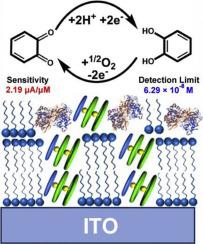当前位置:
X-MOL 学术
›
Enzyme Microb. Technol.
›
论文详情
Our official English website, www.x-mol.net, welcomes your
feedback! (Note: you will need to create a separate account there.)
A voltammetry biosensor based on self-assembled layers of a heteroleptic tris(phthalocyaninato) europium triple-decker complex and tyrosinase for catechol detection
Enzyme and Microbial Technology ( IF 3.4 ) Pub Date : 2020-09-01 , DOI: 10.1016/j.enzmictec.2020.109578 Qi Liu 1 , Lei Zou 2 , Qiqi Sun 1 , Xiyou Li 1 , Yanli Chen 1
Enzyme and Microbial Technology ( IF 3.4 ) Pub Date : 2020-09-01 , DOI: 10.1016/j.enzmictec.2020.109578 Qi Liu 1 , Lei Zou 2 , Qiqi Sun 1 , Xiyou Li 1 , Yanli Chen 1
Affiliation

|
A highly efficient enzyme-based sensor was made from a heteroleptic tris(phthalocyaninato) europium triple-decker complex Eu2(Pc)[Pc(OPh)8]2, for the first time. The ITO working electrode was modified by a mixture of hybrid multi-layers consisting of Eu2(Pc)[Pc(OPh)8]2, stearic acid (SA) and tyrosinase (Tyr) (Eu2(Pc)[Pc(OPh)8]2/SA/Tyr-ITO) using the Langmuir-Blodgett (LB) technique. The microstructure and morphology of the resulting LB films can be characterized by their π-A isotherms, UV-vis absorption spectra, X-ray diffraction and atomic force microscopy (AFM) analysis. The experimental results revealed that the triple-decker molecules of Eu2(Pc)[Pc(OPh)8]2 take a H-type molecular stacking mode in both pure and mixed LB film, and the microstructures of films were effectively improved by mixing SA within the triple-decker Eu2(Pc)[Pc(OPh)8]2 molecules. The excellent electrocatalytic effect of the Eu2(Pc)[Pc(OPh)8]2/SA/Tyr LB films, leads to a good linear increase from 5.26 × 10-7 to 2.1 × 10-4 M for catechol. It also leads to an excellent sensitivity of 2.19 μA/μM, and a detection limits of 6.29 × 10-8 M (S/N = 3) of catehol at the oxidation peak, achieving best catechol sensing performance among the phthalocyanine-based biosensing mediators. The reduction peak also showed a good linear increase from 5.26 × 10-7 to 1.60 × 10-4 M for catechol with a sensitivity of 0.615 μA/μM, and a detection limit of 1.69 × 10-7 M (S/N = 3). Moreover, the Eu2(Pc)[Pc(OPh)8]2/SA/Tyr-ITO electrode are easy to reproduce, stable and resistant to interference when it comes to detection for catehol, and this indicates great potential of industrial application of tris(phthalocyaninato) rare earth complexes in ultrasensitive and specific biosensors.
中文翻译:

基于杂配三(酞菁)铕三层复合物和酪氨酸酶的自组装层的伏安法生物传感器,用于检测儿茶酚
首次由杂配三(酞菁)铕三层复合物 Eu2(Pc)[Pc(OPh)8]2 制成了一种高效的基于酶的传感器。ITO工作电极由Eu2(Pc)[Pc(OPh)8]2、硬脂酸(SA)和酪氨酸酶(Tyr)(Eu2(Pc)[Pc(OPh)8]2 ]2/SA/Tyr-ITO) 使用 Langmuir-Blodgett (LB) 技术。所得 LB 薄膜的微观结构和形态可以通过它们的 π-A 等温线、UV-vis 吸收光谱、X 射线衍射和原子力显微镜 (AFM) 分析来表征。实验结果表明,Eu2(Pc)[Pc(OPh)8]2的三层分子在纯LB膜和混合LB膜中均采用H型分子堆积模式,通过在三层 Eu2(Pc)[Pc(OPh)8]2 分子中混合 SA,有效改善了薄膜的微观结构。Eu2(Pc)[Pc(OPh)8]2/SA/Tyr LB 薄膜优异的电催化效果,导致邻苯二酚从 5.26 × 10-7 线性增加到 2.1 × 10-4 M。它还具有 2.19 μA/μM 的出色灵敏度和 6.29 × 10-8 M (S/N = 3) 氧化峰邻苯二酚的检测限,在基于酞菁的生物传感介质中实现了最佳的邻苯二酚传感性能. 儿茶酚的还原峰也表现出良好的线性增加,从 5.26 × 10-7 M 到 1.60 × 10-4 M,灵敏度为 0.615 μA/μM,检测限为 1.69 × 10-7 M(S/N = 3 )。此外,Eu2(Pc)[Pc(OPh)8]2/SA/Tyr-ITO电极易于复制,
更新日期:2020-09-01
中文翻译:

基于杂配三(酞菁)铕三层复合物和酪氨酸酶的自组装层的伏安法生物传感器,用于检测儿茶酚
首次由杂配三(酞菁)铕三层复合物 Eu2(Pc)[Pc(OPh)8]2 制成了一种高效的基于酶的传感器。ITO工作电极由Eu2(Pc)[Pc(OPh)8]2、硬脂酸(SA)和酪氨酸酶(Tyr)(Eu2(Pc)[Pc(OPh)8]2 ]2/SA/Tyr-ITO) 使用 Langmuir-Blodgett (LB) 技术。所得 LB 薄膜的微观结构和形态可以通过它们的 π-A 等温线、UV-vis 吸收光谱、X 射线衍射和原子力显微镜 (AFM) 分析来表征。实验结果表明,Eu2(Pc)[Pc(OPh)8]2的三层分子在纯LB膜和混合LB膜中均采用H型分子堆积模式,通过在三层 Eu2(Pc)[Pc(OPh)8]2 分子中混合 SA,有效改善了薄膜的微观结构。Eu2(Pc)[Pc(OPh)8]2/SA/Tyr LB 薄膜优异的电催化效果,导致邻苯二酚从 5.26 × 10-7 线性增加到 2.1 × 10-4 M。它还具有 2.19 μA/μM 的出色灵敏度和 6.29 × 10-8 M (S/N = 3) 氧化峰邻苯二酚的检测限,在基于酞菁的生物传感介质中实现了最佳的邻苯二酚传感性能. 儿茶酚的还原峰也表现出良好的线性增加,从 5.26 × 10-7 M 到 1.60 × 10-4 M,灵敏度为 0.615 μA/μM,检测限为 1.69 × 10-7 M(S/N = 3 )。此外,Eu2(Pc)[Pc(OPh)8]2/SA/Tyr-ITO电极易于复制,











































 京公网安备 11010802027423号
京公网安备 11010802027423号